
|
Sale 80
June Pre Long Beach Sale
| Denarii Collection - Roman Imperatorial |
| |
| |
| Lot |
Photo |
Description |
Realized |
Lot 3073 |
 |
Pompey the Great. Silver Denarius (3.9 g), 48 BC. Military mint traveling with Pompey in Greece. Terentius Varro, proquaestor. VARRO PRO Q, diademed bust of Jupiter right. Reverse : MAGN PRO / COS in two lines in exergue, scepter between dolphin swimming right and eagle standing left. Crawford 447/1a; HCRI 8; Sydenham 1033; RSC 3. Very rare. Well struck and well centered, lightly toned. Superb Extremely Fine.
Struck prior to the Battle of Pharsalus in which Pompey was defeated by Caesar, this coin advertises Pompey's most considerable past achievements. Jupiter Terminus (or Terminalis), the divine guardian of boundaries, refers to the grant of proconsular powers awarded to Pompey by the Senate so that he carry the fight to Caesar and save the Republic. The images of the dolphin and eagle represent Pompey's most famous achievements by sea and by land: his decisive defeat of the Cilician pirates in 66 BC, and his conquest over Mithradates VI of Pontus in 65 BC. Additionally, the design of the reverse is divided by a scepter, which here serves not only as an artistic device separating the motifs of the dolphin and eagle, but symbolizes his delegated authority as it was only carried by victorious generals who had been acclaimed imperator by their troops.
Estimated Value $7,000 - 8,000.
Ex Dr. Busso Peuss 401/402 (3 November 2010), 447.
View details and enlarged photos
| Realized
$10,575 |
Lot 3074 |
 |
Q. Metellus Pius Scipio. Silver Denarius (4.07 g), 47-46 BC. Military mint traveling with Scipio in Africa. Imperator, committed sucide in 46 BC. Q METEL above, PIVS below, laureate head of Jupiter right. Reverse : SCIPIO above, IMP in exergue, elephant advancing right. Crawford 459/1; HCRI 45; Sydenham 1050; Caecilia 47. Rare. Perfectly struck and centered on a full flan with gorgeous iridescent toning. A remarkable specimen. Superb Extremely Fine.
A Pompeian loyalist, Q. Metellus Pius Scipio introduced the legislation that recalled Caesar from his Gallic command, thus precipitating the Civil Wars. This handsome denarius was struck while Scipio was in supreme command of the Pompeian forces in North Africa, the elephant an obvious reference to the province, and was probably struck during the later stages of the campaign in a mobile mint traveling alongside the forces (stylistically it is quite distinct from the coins of Scipio struck at the provincial capital of Utica). In 46 BC, Caesar finally managed to corner the Pompeians at Thapsus, where he inflicted on them a crushing defeated. After the battle Scipio committed suicide, knowing that despite Caesar's usual leniency towards his enemies he would not allow so persistent an foe as Scipio to survive.
Estimated Value $5,000 - 6,000.
Ex NAC 62 (6 October 2011), 2001; Spink 5014 (28 September 2005), 386.
View details and enlarged photos
| Realized
$8,813 |
Lot 3075 |
 |
Cnaeus Pompey Jr. Silver Denarius (4.02 g), 46-45 BC. Corduba. Elder son of Pompey the Great, Imperator, executed in 45 BC. IMP CN MAGN, bare head of Pompey the Great right. Reverse : PR Q to left, M MINAT / SABIN in two lines in exergue, Spanish city-goddess standing right, wearing turreted headdress, holding caduceus and clasping hands with Pompeian solder standing facing; to right, another city-goddess standing left, crowning soldier and holding trophy over shoulder. Crawford 470/1c; HCRI 50; Sydenham 1038; RSC 11 (Pompey the Great). An absolutely incredible specimen! Well struck and perfectly centered, all delicately toned. Important Rarity and one of the finest known. Superb Extremely Fine.
Crawford records just five obverse and eight reverse dies for this issue, which suggests this very rare coin was introduced only shortly before Caesar's decisive victory over the Pompeian forces in Spain at Munda in 45 BC. The obverse features the portrait of the deceased Pompey, the central figure in opposition to Caesar until his tragic assassination in Egypt after Pharsalus, while the reverse alludes to Spanish support for the Pompeian cause. Although this issue was very limited to begin with and but few coins remain today (perhaps no more than a dozen specimens all told), it would seem that the coins circulated for some time as most examples exhibit at least some wear. This specimen, on the other hand, is quite pristine, struck on excellent metal, and is likely the finest example in existence.
Estimated Value $35,000 - 40,000.
Ex The Rubicon Collection (Heritage 3015, 7 September 2011), Previously from Stacks (private purchase).
View details and enlarged photos
| Realized
$45,825 |
Lot 3076 |
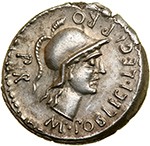 |
Cnaeus Pompey Jr. Silver Denarius (3.92 g), 46-45 BC. Corduba. M. Poblicius, propraetorian legate. M POBLICI LEG PRO PR, helmeted head of Roma right. Reverse : CN MAGNVS IMP, Hispania standing right, shield on her back, holding two spears and presenting palm to Pompeian soldier standing left on prow, armed with sword. Crawford 469/1a; HCRI 48; Sydenham 1035; RSC 1 (Pompey the Great). Well struck and perfectly centered on a nice broad flan, lightly toned. Superb Extremely Fine.
The reverse type represents the support of Further Spain for the Pompeian cause. The female figure, who Crawford does not identify, is obviously Hispania, coming to lend her support (arms) which will lead to ultimate victory (palm-branch) and the restoration of a constitutional Republic.
Estimated Value $2,000 - 2,500.
Ex Goldberg 70 (2-5 September 2012), 3201; NAC 41 (20 November 2007), 15.
View details and enlarged photos
| Realized
$3,995 |
Lot 3077 |
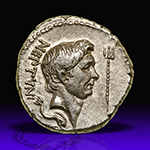 |
Sextus Pompey, younger son of Pompey the Great, Silver Denarius (3.44 g), 42-38 BC. Executed 35 BC. Minted in Massilia. Q. Nasidius, commander of the fleet. NEPTVNI behind, bare head of Pompey the Great right; before, trident; below, dolphin right. Reverse : Q NASIDIVS in exergue, galley with billowing sail and bank of rowers moving right; in upper left field, star. Crawford 483/2; HCRI 235; Sydenham 1350; RSC 20 (Pompey the Great). Very Rare. Well centered on a full flan with the head of Pompey in high relief. A remarkable example! Extremely Fine.
Q. Nasidius was a Pompeian loyalist, having first served under Pompey unsuccessfully defending Massalia from the Caesarian forces under Decimus Brutus in 49 BC. Later he commanded the fleet of the Pompeian forces in north Africa until the disaster at Thapsus, after which he left for Spain to join with Pompey's son, Cn. Pompey Jr. He subsequently served as supreme naval commander under Sextus Pompey at Massilia, where this handsome coin was struck. Eventually Nasidius saw the futility of the Pompeian cause, deserting to Mark Antony where he fought at Actium in 31 BC.
Estimated Value $20,000 - 25,000.
Ex S. C. Markoff Collection (NAC 62, 6 October 2011), 2002.
View details and enlarged photos
| Realized
$41,125 |
Lot 3078 |
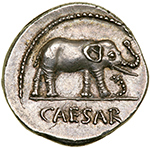 |
Julius Caesar. Silver Denarius (3.98 g), 49-48 BC. Military mint traveling with Caesar. CAESAR in exergue, elephant advancing right, trampling horned serpent. Reverse : Pontifical implements: simpulum, sprinkler, axe and priest's hat. Crawford 443/1; HCRI 9; Sydenham 1006; RSC 49. Well struck in high relief with pleasing old cabinet toning. Superb Extremely Fine.
Perhaps the most ubiquitous of Caesar's denarii, this famous issue was struck at the time of his crossing of the Rubicon and the beginning of the long period of civil wars which resulted in the downfall of the Roman Republic. A few theories have been presented explaining the obverse type, the most established being that the elephant represents good, the serpent evil, thus a message of the righteousness of Caesar's cause. The reverse shows the symbols of Rome's high priest, the Pontifex Maximus, Caesar having been elected to the office in 63 BC.
Estimated Value $2,000 - 2,500.
View details and enlarged photos
| Realized
$4,230 |
Lot 3079 |
 |
Julius Caesar. Silver Denarius (3.87 g), 48-47 BC. Military mint traveling with Caesar in North Africa. Diademed head of Venus right. Reverse : CAESAR, Aeneas advancing left, holding palladium and bearing Anchises upon his shoulder. Crawford 458/1; HCRI 55; Sydenham 1013; RSC 12. Well struck on a nice broad flan with lustrous surfaces throughout. Superb Mint State.
The Roman nobility was always at pains to claim descent from either the gods or from mythical heroes, or even more often from both. The Julia gens claimed mythical descent from Iulus, son of the Trojan hero Aeneas, who himself was the son of the goddess Venus and Anchises. Although not struck on as massive a scale as Caesar's well-known elephant type of 49-48 BC, this type is considerably more common than any other coin of Caesar, and was struck to pay for Caesar's protracted North African campaign against the Pompeians.
Estimated Value $1,500 - 2,000.
Ex NAC 40 (16 May 2007), 549.
View details and enlarged photos
| Realized
$3,525 |
Lot 3080 |
 |
Julius Caesar. Silver Denarius (3.97 g), 44 BC. Rome. C. Cossutius Maridianus, moneyer. CAESAR before, PARENS PATRIAE behind, wreathed and veiled head of Julius Caesar right; behind, apex; below chin, lituus. Reverse : C COSSVTIVS MARID-IANVS arranged in the form of a cross with A-A-A-F F in the four angles. Crawford 480/19; HCRI 112 = Sear 1422 (this coin illus.); Sydenham 1069; RSC 8. Well centered on a broad flan with underyling luster, lightly toned. Superb Extremely Fine. A rare and exceptional denarius.
The abbreviation A A A F F (quattuorvir aere argento auro flando feriundo) that appears on the reverse of this coin is the first occurrence of the complete title of the moneyer on a coin.
Estimated Value $25,000 - 30,000.
Ex Goldberg 65 (6 September 2011), 4123; NFA Auction XXVII (4 December 1991), 626.
View details and enlarged photos
| Realized
$79,313 |
Lot 3081 |
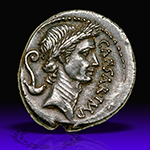 |
Julius Caesar. Silver Denarius (3.77 g), 44 BC. Rome. M. Mettius, moneyer. CAESAR IMP, laureate head of Julius Caesar right; behind, lituus and simpulum behind. Reverse : M METTIVS, Venus standing facing, head left, holding Victory and scepter, resting elbow on shield set on globe behind her; in left field, G. Crawford 480/3; Alföldi type III, pl. XII, 26 (this coin); HCRI 100; Sydenham 1056; RSC 32. Rare and in exceptional state of preservation. A remarkable portrait of fine detail. Lovely dark tone with lighter iridescent highlights. Superb Extremely Fine.
In 44 BC the Senate honored Caesar with the right to place his portrait on the coinage. This presented a revolutionary change as never before had the effigy of a living Roman appeared on the coinage of the Republic (there is the instance of the exceedingly rare gold staters of T. Quinctius Flamininus struck in Macedon 196 BC, but those are not Roman issues). Whether this was simply another honor bestowed by the Senate to appeal to Caesar's vanity or it implied his acceptance of the role of monarch is debated, but certainly the average Roman interpreted it as monarchical aspirations of the dictator: within three months Caesar was dead, struck down by the conspirators on the Ides of March, 44 BC.
Estimated Value $30,000 - 35,000.
Ex The Rubicon Collection (Heritage 3015, 7 September 2011), 23260; NAC 38 (21 March 2007), 1; Bank Leu 10 (29 May 1974), 8; Levis Collection (Ars Classica XI, 18 June 1925), 157.
View details and enlarged photos
| Realized
$99,875 |
Lot 3082 |
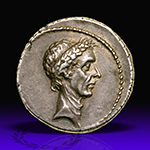 |
Julius Caesar. Dictator from 49 BC, assassinated 44 BC. Silver Denarius (3.89 g), 43 BC. Rome. L. Flaminius Chilo, moneyer. Laureate head of Julius Caesar right. Reverse : L FLAMINIVS III VIR, female figure (Venus or Pax) standing facing, head left, holding caduceus and scepter. Crawford 485/1; HCRI 113; Sydenham 1089; RSC 26. Well struck on a large flan. A remarkable realistic portrait of fine style. Attractive old cabinet tone with a hint of iridescense. Superb Extremely Fine.
We know very little about the moneyer Chilo, and it may be that he should be identified with the 'Cillo' who was proscribed late in the year that this coin was struck, having run afoul of the Triumvirs, Antony and Octavian. If so, this obviously pro-Caesarian type did not save him.
The identity of the female figure on the reverse is uncertain. The type resembles the moneyer issues of the preceding year, which portray Venus standing left, holding Victory and scepter. In this case, however, the goddess holds a caduceus, a symbol most associated with the personification Felicitas or happiness. It may be that instead of Venus the figure is the goddess Pax. Pax is often shown holding a caduceus, which represents the stability associated with peaceful times.
Estimated Value $30,000 - 35,000.
View details and enlarged photos
| Realized
$58,750 |
Lot 3083 |
 |
Julius Caesar. Silver Denarius (3.9 g), 42 BC. Rome. L. Livineius Regulus, moneyer. Wreathed head of Julius Caesar right; behind, laurel branch; before, winged caduceus. Reverse : L LIVINEIVS above, REGVLVS below, bull charging right. Crawford 494/24; HCRI 115; Sydenham 1106; RSC 27. Rare. Lustrous with the obverse perfectly centered. One of the finest examples extant. Superb Extremely Fine.
The significance of the reverse is not certain. It most probably refers to an event of 47 BC, mentioned by both Dio Cassius (xli.39.2) and Suetonius (Caes. 59), where during the African War Caesar was performing a sacrifice before the impending battle at Thapsus against the combined forces of Scipio and Juba. The sacrificial bull escaped, but despite this ominous omen Caesar was not dissuaded from commencing battle. We know that a praetor by the name of L. Livineius Regulus served with Caesar during the African War, and we can assume that this praetor, who perhaps was present and played a significant role at Thaspus, was a close relation of the moneyer. Of course this reference to the sacrifice at Thapsus is not the only interpretation of the reverse. The bull also represents the zodiacal sign of Taurus in Venus, and thus we should probably see an allusion to Caesar's claimed divine descent from the goddess Venus.
Estimated Value $25,000 - 30,000.
Ex Goldberg 65 (4-6 September 2011), 4124.
View details and enlarged photos
| Realized
$34,075 |
Lot 3084 |
 |
Julius Caesar. Silver Denarius (4.11 g), 42 BC. Rome. P. Clodius M.f. Turrinus, moneyer. CAESAR before, IMP behind, laureate head of Julius Caesar right. Reverse : P CLODIVS on left, M F on right, Mars standing facing, head left, holding spear and parazonium. Crawford 494/16; HCRI 114; Sydenham 1123; RSC 37. Boldly struck on a full size flan with incredible detail. Lovely old cabinet tone with a hint of iridescense. An exceptional example, one of the finest in existence. Superb Extremely Fine.
The moneyer, P. Clodius, son of Marcus, of whom nothing is known, returned to the realistic style of portraiture that typifies Caesar's lifetime issues and which had been replaced the year before with an idealized effigy of Caesar under the moneyer Flamininus. There are parallel issues by P. Clodius for both Mark Antony and Octavian (Crawford 494/17 and 494/18 respectively), each employing the same reverse type of Mars. The issue was struck to finance the anticipated war against the republican forces of Brutus and Cassius in the East.
Estimated Value $50,000-UP.
Ex UBS 78 (9-10 September 2008), 1131; Ernst Justus Haeberlin Collection (A.Cahn/A. Hess, 17 July 1933), 2930.
View details and enlarged photos
| Realized
$199,750 |
Lot 3085 |
 |
Julius Caesar. Silver Denarius (4.10 g), 40 BC. Rome. Q. Voconius Vitulus, moneyer. DIVI IVLI before, laureate head of Julius Caesar right; behind, lituus. Reverse : Q VOCONIVS above, VITVLVS in exergue, bull-calf walking left. Crawford 526/2; HCRI 329; Sydenham 1132; RSC 46. Boldly struck and well centered on a full flan. An exceptional portrait of Caesar! Lovely toned surfaces with hints of iridescense. Nearly Mint State.
With the exception of a short period during the principate of Augustus, it is with the coins of Q. Voconius Vitulus and his colleague, Tiberius Sempronius Gracchus, in 40 BC that the long tradition of a college of moneyers producing currency at the Capitoline mint ended. The year before with the outcome of the Perusine War between Octavian and Lepidus still to be decided, the moneyers hedged their bets by using purposefully ambiguous types on their coins: M. Arrius Secundus' denarii (Crawford 513/2 and 513/3) used an ancestor's portrait that resembled Octavian; C. Numonius Vaala's aurei (Crawford 514/1) employed the head of Victory, the portrait of which is clearly Fulvia, Mark Antony's wife; and L. Servius Rufus' denarii (Crawford 515/2) have an ancestor's portrait which is most obviously Brutus. In each case the choice of types could be argued to favor the winning side, whichever side that may be. By 40 BC, however, the Perusine War was safely behind Octavian who was now firmly in control of the West, and perhaps angered by these shenanigans at the mint he decided to bring it firmly under his own authority.
Estimated Value $50,000-UP.
Ex C. K. Collection (Triton XIV, 3 January 2011), 605.
View details and enlarged photos
| Realized
$111,625 |
Lot 3086 |
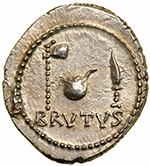 |
Brutus. Silver Denarius (3.75 g), 42 BC. Military mint, probably at Smyrna. P. Lentulus Spinther, legate. BRVTVS below, simpulus between sacrificial axe and knife. Reverse : LENTVLVS/SPINT in two lines below, jug and lituus. Crawford 500/7; HCRI 198; Sydenham 1310; RSC 6. Boldly struck and well centered on a borad flan, all lightly toned. Superb Extremely Fine.
The types chosen for this issue indicate both Brutus' membership in the college of pontifices and the legate's, P. Lentulus Spinther, membership in the augurate. The pontificate and augurate were Rome's foremost priestly colleges, the former supervising all of the other priestly colleges, and the later being responsible for reading the signs of the gods to determine whether or not an anticipated undertaking would be divinely supported or opposed. The priestly symbols on this issue, which was struck to pay the military expenses of the tyrannicides while preparing for the expected showdown with the Triumvirs, suggests divine support and the just nature of their cause.
Estimated Value $3,000 - 3,500.
View details and enlarged photos
| Realized
$8,519 |
Lot 3087 |
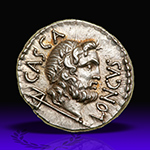 |
Brutus. Silver Denarius (3.82 g), 42 BC. Military mint traveling with Brutus and Cassius in western Asia Minor or northern Greece. P. Servilius Casca Longus, moneyer. CASCA behind, LONGVS before, Laureate and bearded head of Neptune right; trident below. Reverse : BRVTVS behind, IMP before, Victory advancing right, breaking diadem tied with fillet and holding palm; below, broken scepter. Crawford 507/2; HCRI 212; Sydenham 1298; RSC 3. Boldly struck and well centered. Needle sharp in detail, lustrous and delicately toned. Superb Extremely Fine.
On this splendid coin the image of Victory trampling upon a broken scepter and tearing the diadem powerfully evoke the long tradition of Roman hatred for monarchical rule. It was rumored that Julius Caesar had inclined to become king, purportedly wearing red boots as the Roman kings had worn and having his statue placed next to those of the kings, and these were all used by the tyrannicides to justify his assassination. The obverse type of Neptune was an obvious choice for Casca, who was the commander of Brutus' fleet.
Estimated Value $10,000 - 12,000.
Ex Helios 2 (25-26 November 2008), 221.
View details and enlarged photos
| Realized
$19,388 |
Lot 3088 |
 |
Brutus. Silver Denarius (3.76 g), 42 BC. Military mint traveling with Brutus and Cassius in western Asia Minor or northern Greece. L. Plaetorius Cestianus, moneyer. L PLAET CEST behind, laureate, veiled and draped female bust right, her head surmounted by polos. Reverse : BRVT IMP, sacrificial axe and simpulum (or culullis). Crawford 508/2; HCRI 214; Sydenham 1300; RSC 2. Very Rare. Boldly struck in high relief and fine style. A lovely example with attractive old cabinet toning. Extremely Fine.
The identification of the female depicted on the obverse is uncertain. Older catalogues refer to her as Ceres, the Roman goddess of agriculture, while Crawford suggests Diana, but the type is ambiguous. Like the earlier issue in the name of Brutus struck by Cassius' legate, P. Lentulus Spinther, on the reverse we see again Brutus' priestly emblems of the pontificate, suggesting the divine right of the liberators' cause. The issue was struck immediately preceding the fateful battle of Philippi, and was perhaps Brutus' penultimate issue, the last of course being the renowned Eid Mar type which also appears in this sale.
Estimated Value $25,000 - 30,000.
Ex NAC 70 (16 May 2013), 184; Virgil M. Brand Collection, pt. 3 (Sotheby's, 9 June 1983), 238; Ernst Herzfelder Collection (Brüder Egger XLIII, 14 April 1913), 55.
View details and enlarged photos
| Realized
$47,000 |
Lot 3089 |
 |
Brutus. Silver Denarius (3.52 g), 42 BC. Mint moving with Brutus in northern Greece. L. Plaetorius Cestianus, magistrate. BRVT above, IMP before, L PLAET CEST behind, bare head of Brutus right. Reverse : EID MAR, pileus between two daggers. Crawford 508/3; Cahn 13b; HCRI 216; Sydenham 1301; Mazzini pl. V, 15 (same dies); Naville XV, 1315 (same dies); RSC 15. An incredible example in outstanding condition for this issue of great historical importance. Boldly struck with an incredible, well defined portrait on a full broad flan with minor porosity, all lightly toned. The ultra important reverse is simply breathtaking! Among the finest known examples. Superb Extremely Fine. Includes an NGC photo-cert as follows: Choice AU; Strike: 5/5, Surface: 3/5, Fine Style.
The highly provocative design of the reverse of this most famous of Roman coins, the Eid Mar denarius, presents us with the fait accompli of Caesar's assassins. The coin loudly proclaims that the hated tyrant is dead and that the deed was done in the name of liberty.
On the Ides of March 44 BC, M. Junius Brutus and C. Cassius Longinus led a host of other senators to rid Rome of Julius Caesar. Caesar had been proclaimed dictator for life and held absolute power, holding all of Rome's top offices. Many felt he aspired to become king. Not only did he already have all the powers of an absolute monarch, just three months prior to his assassination he committed his most egregious affront to Roman sensibilities when usurped the royal prerogative of placing his own image on the coinage. Never before had a living Roman's portrait appeared on the coinage, and in the minds of the conspirators this must have been the final straw, the fatal coalescing of all their enmity. Caesar paid with his life, and the fabric of the Republic was torn asunder.
It took time after Caesar's assassination for the situation to develop to the point of open civil war. At first, Antony as leader of the Senate proclaimed a general amnesty for the conspirators, but after the establishment of the Second Triumvirate between Octavian, Mark Antony and Lepidus in November 43 BC, the conspirators were declared public enemies. Being the leaders of the conspiracy to assassinate Caesar, Brutus and Cassius had long before fled Rome, their safety at risk from the Roman mob. In early 42 BC, however, they joined forces at Sardes in Asia Minor and began preparations for the final showdown with the triumvirs. By the summer they were in Macedonia en route to engage the forces of Antony and Octavian.
The first battle of Philippi took place to the west of the town on October 3. Brutus faced Octavian while Cassius engaged Antony. Brutus successfully pushed back the forces of Octavian, but those of Cassius were routed by Antony, and on hearing a false report that Brutus had been defeated and killed, Cassius committed suicide. The second battle took place on October 23 and saw the combined forces of the conspirators under the sole command of Brutus. They proved no match for the triumvirs, however, and Brutus was soundly defeated. Seeing that all was lost, he too committed suicide.
The Eid Mar denarius was struck to pay Brutus' troops and campaign expenses. His choice of types are both appropriate on the one hand and ironic on the other. The reverse depicts the pileus, or cap of liberty traditionally given to slaves when they were freed, between the daggers representing the death of Caesar, while the legend EID MAR records the date the Republic was released from Caesar's tyranny. The message is unequivocal and follows the long Roman tradition of proclaiming illustrious events of one's family on the coinage. Of course, what was more important for Brutus than his own involvement in the restoration of the Republic by ridding it of Caesar? The obverse is different, however. If the appearance of Caesar's portrait on coinage was the final straw that precipitated the actions of the conspirators, then surely it would be improper (ironic even) for Brutus to place his own portrait on his coins. However, by this time the triumvirs were already placing their own portraits on coins (see Crawford 494), and Brutus was merely following their footsteps.
Estimated Value $250,000-UP.
View details and enlarged photos
| Realized
$517,000 |
Lot 3090 |
 |
C. Cassius Longinus. Silver Denarius (4.0 g), 42 BC. Military mint, probably at Smyrna. Conspirator, commited suicide in 42 BC. P. Lentulus Spinther, legate. C CASSI IMP behind, LEIBERTAS before, diademed, veiled and draped bust of Libertas right. Reverse : LENTVLVS/SPINT in two lines below, jug and lituus. Crawford 500/5; HCRI 223; Sydenham 1305; RSC 6. Boldly struck in high relief and well centered. Beautifully toned with hints of iridescense. Superb Extremely Fine.
Libertas's portrait on this coin is quite lovely, showing a certain graciousness and competent ability not evident on the parallel issues with an unveiled Libertas where the goddess is depicted with a rather large jowl and chin more in line with a caricature portrait. In instances such as this, we must wonder if the engraver was simply more skilled or if perhaps he had a local beauty sit for him whose likeness he skillfully copied.
Estimated Value $4,000 - 5,000.
Ex Triton XI (8-9 January 2008), 612; Freeman & Sear List 6 (Summer 2001), F87.
View details and enlarged photos
| Realized
$8,813 |
Lot 3091 |
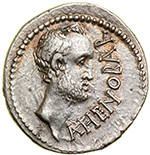 |
Cn. Domitius Ahenobarbus. Silver Denarius (3.92 g), 41-40 BC. Uncertain mint in the region of the Adriatic or Ionian Sea. Imperator, died 31 BC. AHENOBAR, head of L. Ahenobarbus right. Reverse : CN DOMITIVS IMP, trophy set on prow of galley right. Crawford 519/2; HCRI 339; Sydenham 1177; Domitia 21. Well struck on a sound planchet with delicate golden toning. An enchanting specimen with an excellent portrait of the Imperator. Extremely Fine.
Originally a Pompeian loyalist, Ahenobarbus allied with Brutus and Cassius after the Ides of March. After Philippi he engaged the fleet of the triumvirs under the command of Domitius Calvinus, inflicting a resounding defeat for which he was hailed imperator by his troops, which the reverse of this coin commemorates. Subsequently, however, he joined Antony in opposing Octavian, but then deserted to Octavian before Actium, having become disgusted with Antony's alliance with Cleopatra. Aside from his involvement in the civil wars that racked Rome in the latter half of the first century BC, Ahenobarbus is also remember for being the paternal great-grandfather of the future emperor Nero.
Estimated Value $7,000 - 8,000.
Ex Gemini V (6 January 2009), 778.
View details and enlarged photos
| Realized
$8,813 |
Lot 3092 |
 |
Q. Labienus. Silver Denarius (3.74 g), 40 BC. Uncertain mint in Syria or southeastern Asia Minor. Imperator, executed in 39 BC. Q LABIENVS PARTHICVS IMP, bare head of Labienus right. Reverse : Horse standing right on ground line, wearing saddle with quiver attached and bridle. Crawford 524/2; Hersh 23; HCRI 341; Sydenham 1357; RSC 2. Extremely Rare. Boldly struck with a magnificent portrait of superb style in high relief, struck on a full flan, unusually fine metal and delicately toned. Among the finest specimens known. Superb Extremely Fine.
Quintus Labienus was the son of the Pompeian cavalry commander Titus Labienus. He sided with Brutus and Cassius in the war between the Republicans and the Triumvirs, and during the winter of 43/2 BC was sent by Cassius on an embassy to seek Parthian assistance in the Republican cause. Before he was able to do accomplish this task, however, he received the devastating news that Brutus and Cassius had been defeated at Philippi. Thus he found himself in the unpleasant situation of being stranded in Parthia and unable to return to Rome, where his former enemies were now unquestionably in control and would certainly execute him for being a traitor if he were to return.
With nothing to lose, Labienus convinced King Orodes II to allow him a force of 20,000 cavalry, and with the king's son, Pacorus, he marched into Syria. Labienus and Pacorus, splitting the command between them, quickly overcame Roman resistance, defeating the local governor, Decidius Saxa. While Labienus continued into southern Asia Minor, Pacorus headed west and south into Phoenicia and Palestine. Although Antony realized the seriousness of the situation, his attention was called for in the West. He therefore sent his legate Ventidius Bassus with eleven legions to oppose the Parthian invasion, and Bassus routed the Parthian cavalry at Mt. Taurus where Labienus was killed.
The obverse of this extremely rare issue shows the handsome portrait of Labienus along with his name and titles, while the reverse depicts a saddled horse complete with archer's bow-case, a feature used by the Parthians who were most renowned for their mounted archers. Thus, the coin seems to have been designed to appeal to both a Roman and a Parthian audience, although perhaps shortsighted, as certainly no Roman would have considered the design as anything less than unconscionable. In any case, the extreme rarity of the coins today suggests the majority of them were melted down shortly after Labienus' defeat.
Estimated Value $150,000 - 200,000.
Ex S. C. Markoff Collection (NAC 62, 6 October 2011), 2009.
View details and enlarged photos
| Realized
$235,000 |
Lot 3093 |
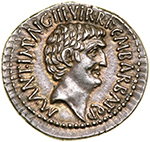 |
Mark Antony & Octavian. Silver Denarius (3.76 g), 41 BC. Ephesus. M. Barbatius Pollio, quaestor pro praetore. M ANT I(MP) (AV)G III VIR R P C M BARBAT Q P, bare head of Mark Antony right. Reverse : CAESAR IMP PONT III VIR R P C, bare head of Octavian right. Crawford 517/2; HCRI 243; Sydenham 1181; RSC 8a. Boldly struck on a broad flan. Beautiful old cabinet toning with hints of iridescense. Superb Extremely Fine.
Mark Antony is reported to have lived extravagantly while in the East, and he exacted large sums from the cities of Asia Minor to finance this lifestyle. It is certainly from these funds where he obtained the bullion to produce this extensive and handsome coinage, struck with the name of his lieutenant M. Barbatius Pollio. Pollio's colleagues, M. Cocceius Nerva (a distant ancestor of the future emperor Nerva) and L. Gellius Poplicola, also struck similar types honoring both Antony's fellow triumvir, Octavian and his brother, Lucius Antony, but the majority are of a different style and are believed to have been struck after Antony's departure from Ephesus.
Estimated Value $4,000 - 5,000.
Ex LHS 100 (23-24 April 2007), 455.
View details and enlarged photos
| Realized
$9,400 |
Lot 3094 |
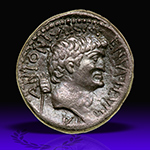 |
Mark Antony & Cleopatra VII. Silver Denarius (3.63 g), 34 BC. Alexandria. ANTONI ARM-ENIA DEVIC-TA, head of M. Antony right; behind, Armenian tiara. Reverse : CLEOPATRAE [REGINAE] REGVM FILIORVM REGVM, diademed and draped bust of Cleopatra right; below, prow of galley right. Crawford 543/2; HCRI 345; Newman 34.3; Sydenham 1210; RSC 1. Mostly well struck and perfectly centered with two exceptional portraits. Well toned. Extremely Fine.
In the autumn of 34 BC Antony celebrated an unusual and ostentatious (even by Roman standards) triumph through the streets of Alexandria. The event was staged to play up his successes in conquering Armenia, although he had summarily failed in the main objective of the campaign, which was the conquest of Parthia. The parade ended at the Gymnasium of Alexandria, where the entire citizen body hand been assembled to witness what has become known as the 'Donations of Alexandria'. For the spectacle, Antony and Cleopatra dressed as Dionysus-Osiris and Isis-Aphrodite, and sat upon massive golden thrones, with Cleopatra's young son by Julius Caesar, Caesarion, dressed as Horus beside them. Cleopatra's other children were dressed in the attire of the kingdoms they were to inherit. For the Donations, Antony affirmed Cleopatra as queen of Egypt, Cyprus, Libya and parts of Syria, and bestowed upon her children the eastern provinces of Rome from Cilicia to North Africa, as well as Parthia which remained unconquered. As for Caesarion, he was proclaimed the son and legitimate heir of the deified Julius Caesar, and affirmed as King of Egypt.
Antony sent an announcement to the Senate requesting confirmation of the Donations, but the Senate refused to countenance such an affront to the dignity of Rome. Ocatavian, who was Caesar's heir through adoption, was of course threatened by Antony's claiming Caesarion Caesar's legitimate heir, and this perhaps above all else led to the outbreak of the final confrontation between Octavian and Antony.
The coin is truly remarkable. Never before had the portrait of a foreign head of state appeared on a Roman coin. Additionally, the legend joined with Cleopatra's portrait proclaims "of Cleopatra, Queen of Kings and of her sons (children) who are Kings," thus affirming the Donations that Antony had bestowed. Finally, this coin uses a previously unknown die with a new legend break (DEVIC-TA). Neither are illustrated in Banti nor the photofiles of either the British Museum or the ANS.
Estimated Value $25,000 - 30,000.
Published in the Celator in 2012.
View details and enlarged photos
| Realized
$67,563 |
Lot 3095 |
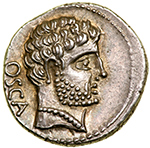 |
Cn. Domitius Calvinus. Silver Denarius (3.86 g), 39 BC. Osca. Imperator in Spain, 39-36 BC. OSCA, bearded male head right. Reverse : DOM COS ITER IMP, simpulum, aspergillum, axe and apex. Crawford 531/1; HCRI 342; Sydenham 1358; Burgos 1509. A magnificent example, well struck and well centered. Lovely old cabinet tone with a hint of iridescense. Nearly Mint State. Rare.
Cn. Domitius Calvinus was stalwart Caesarean, having served as Caesar's Master of the Horse. He commanded the Caesarean center at Pharsalus and was present at Thapsus, and in 39 BC Octavian appointed him governor of Spain with instructions to put down a revolt of the Cerretani. The province, which had recently been ceded to Octavian after Sextus Pompey's defeat, was in a state of extreme turmoil following years of misrule and civil war. Calvinus was known as a strict disciplinarian, and was a good choice for the job as he quickly put down the revolt and restored order to the province. While in Spain he established his capital at Osca where he minted these denarii. The obverse directly copies the bearded male head found on Spanish denarii of the second and first centuries BC, and the reverse presents the symbols showing he was a member of the college of pontifices.
Estimated Value $5,000 - 7,000.
Ex NAC 52 (7 October 2009), 299; Gorny & Mosch 107 (2 April 2001), 339.
View details and enlarged photos
| Realized
$9,694 |
Lot 3096 |
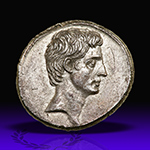 |
Octavian. Silver Denarius (3.73 g), 32-31 BC. Uncertain Italian mint (Rome?). Bare head of Octavian right. Reverse : CAESAR DIVI F, Pax standing facing, head left, holding olive-branch and cornucopiae. RIC 252; HCRI 399; BMC 605-8; RSC 69. An exceptional example of this very rare issue. A magnificent portrait of fine style and fully struck on a full flan. Lustrous and lightly toned. Superb Extremely Fine.
Estimated Value $15,000 - 18,000.
Ex Alberto Campana Collection (NAC 64, 17-18 May 2012), 994.
View details and enlarged photos
| Realized
$30,550 |
Lot 3097 |
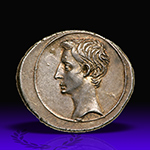 |
Octavian. Silver Denarius (3.87 g), 31-30 BC. Uncertain Italian mint (Rome?). Bare head of Octavian left. Reverse : CAESAR DIVI F, Victory standing left on globe, holding wreath and palm. RIC 254b; HCRI 407; BMC 603; RSC 64. Very scarce and seldom seen like this. Boldly struck on an exceptionally broad flan with a fine sensitive portrait of the future Augustus. Lovely old cabinet tone with hints of iridescense. Superb Extremely Fine.
Octavian's coinage of 31-30 BC is filled with the imagery of his recent victory over Mark Antony, such as on the reverse of this splendid coin. Here Victory is shown with her wreath and victory palm atop the celestial globe, signifying the end of the civil wars and world dominion.
Estimated Value $8,000 - 9,000.
Ex UBS 78 (9-10 September 2008), 1226; Tinchant Collection.
View details and enlarged photos
| Realized
$21,738 |
Lot 3098 |
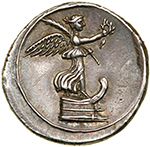 |
Octavian. Silver Denarius (3.9 g), 30 BC. Uncertain Italian mint (Rome?). Victory standing right on prow, holding wreath and palm. Reverse : IMP CAESAR in exergue, Emperor, holding branch and reins, driving triumphal quadriga right. RIC 264; HCRI 416; BMC 617; RSC 115. Boldly struck on a full flan and well centered. Lovely old cabinet toning. Superb Extremely Fine.
Sear states that this is probably the first type of the IMP CAESAR series, having replaced an identical type with the legend CAESAR DIVI F. While the obverse type certainly harkens back to Actium, the reverse commemorates Octavian's entry into Alexandria, where he immediately seized the Ptolemaic treasury. This coin, in fact, was likely struck from the first batch of Ptolemaic silver received in Rome.
Estimated Value $3,000 - 3,500.
Ex The Bru Sale 3 (6 May 2011), 74; Tradart (12 December 1991), 242; Bank Leu 20 (25-26 April 1978), 197.
View details and enlarged photos
| Realized
$5,405 |
|
|